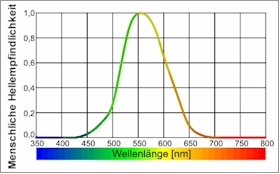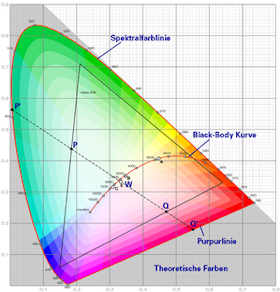|
|
3 steps to the right LED
PLEASE NOTE!!!: Our German sites are much more detailed then our English sites. So please switch in our Germen sites and use the language translater (top right) with 60 languages.
A small public-opinion poll showed that only very few humans know about the lights, which light up there home or workplace. For those who do not have the time to read all our “LED function” sides, we concentrate the 3 most important criteria, which one should consider with the purchase of an LED.
Step ONE
Price - Performance Ratio, Lumen/Watt (lm/W)
| Leuchtmittel | Lumen,lm | lm/W | Lichtstärke,cd |
|---|---|---|---|
| Kerze 42W | 12 | 0,3 | 1 |
| Glühbirne 15W | 100 | 6,6 | 7,96 |
| Glühbirne 25W | 200 | 8 | 15,92 |
| Glühbirne 40W | 400 | 10 | 31,83 |
| Glühbirne 60W | 700 | 11,6 | 55,71 |
| Glühbirne 75W | 900 | 12 | 71,62 |
| Glühbirne 100W | 1.350 | 13,5 | 119,37 |
| Glühbirne 150W | 2.000 | 13,3 | 159,16 |
| Glühbirne 200W | 3.000 | 15 | 238,74 |
| LED Birne12W | 1150 | 96!!! | 183 |
Data in Lumen (lm):
Many LED manufacturers indicates the luminous flux in Lumen (lm) and the consumption in Watt (W). Divides one lm by W he obtains a very good reference value, which indicates the efficiency of a lamp, even:
Lumen/Watt (lm/W)
One can figure lumen, like an intransparent purchase bag. I stand infront of the fruit section with an enormous shelf of apples. There are green, yellow, red, small and large apples. The price tag indicates: All apples cost the same. You mixes some sorts, the shop assistant packs it into the bag and you pay at the cashier by weight. That means, only the weight is important to the cashier but not whether your apples are green or large. With lumen it behaves so similarly. Lumen indicates the entire light achievement (weight). It never mind if the LED has a beam angle, where the entire light is concentrated or you bought a 360° LED. Only the entire light achievement counts!
Untder Watt (W) one can figure as his personal WORK. The more highly the number of Watts, the more one must work, to pay its electricity bill.
High number of Watts - high electricity bill and environmental impact.
Small number of Watts - the environment and your wallet will thank it you.
Is W not indicated but Milliamper (mA 1A = 1000mA) and volt (V) than: W = A x V
To consider would be here still the life span. It is clearly obvious that, if one must change every 6 months its lamp, it is not realy cheap. LEDs shine up to 50,000 hr. I.e. at 5 hr. on the day, 330 times in the year, that would be 30 years!!!
|
Lighting conditions: Midday sun light in summer Covered skies in summer Rain weather with dark thunderclouds Office lighting Living room Stairway lighting Road lighting Twilight after sunset Midnight with full moon Moonless starry sky at night |
Illuminance: 100.000 Lux 10.000 Lux 1000 Lux 500 Lux 200 Lux 100 Lux 10 Lux 1 Lux 0,2 Lux 0,0005 Lux |
In our synoptical table the Lux values would be the cd number for a distance of 1m.
If LED manufacturer only indicate the lux, it is a little more difficult the conversion in lumen, because mostly only the reflected beam angle is indicated however not the Sterad (sr). The sr is the solid angle, which is necessary for the computation. Therefore we arranged the lower SR table.
In order to receive lumens, one must take the indicated distance (r) in meters to the square and multiply it by the solid angle to get the lighted surface (A), thus:
Now one must multiply only A by the lux to receive the lumens.
Who wants to compute the SR, proceeds as follows: 4 x Pi x (sin x (X°/4))² = sr
| Angle: | 180° | 170° | 160° | 150° | 140° | 130° | 120° | 110° | 100° | 95° | 90° | 85° | 80° | 75° | |
| sr Factor | 6,2832 | 5,7356 | 5,1921 | 4,6570 | 4,1342 | 3,6278 | 3,1416 | 2,6793 | 2,2444 | 2,0383 | 1,8403 | 1,6507 | 1,4700 | 1,2984 | |
| Angle: | 70° | 65,55° | 60° | 55° | 50° | 45° | 40° | 35° | 30° | 25° | 20° | 15° | 10° | 5° | 1° |
| sr Factor | 1,1363 | 1,0003 | 0,8418 | 0,7099 | 0,5887 | 0,4783 | 0,3789 | 0,2908 | 0,2141 | 0,1489 | 0,0955 | 0,0538 | 0,0239 | 0,0060 | 0,00024 |
Data in Candela (cd, mlcd, 1cd = 1000mlcd):
Luminous intensity is the radiating power of a source of light in a particular direction
If LED manufacturer only indicate Candela (cd) you have to multiply thecd with thesr.
Step TWO
Which mood would I like to produce?
WHITE IS NOT EQUAL TO WHITE! WHITE IS NOT EQUAL TO WHITE! Therefore the color temperature in Kelvin (K) is indicated.
A candle e.g. possesses a color temperature of 1500°K, thus yellowish, easily reddish light. A 100W bulb has already 2800°K and is also called as warmly WHITE (high yellow portion). The more the color temperature rises the more “whiter” the light gets and we will feel it than “colder” (4000°K). If the color temperature rises continues, the coldly white change in the bluish (12000°K). (e.g. dawn, “the blue hour”)
|
Source of light / Color temperature Candela 1.500 K Bulb (40 W) 2.680 K Bulb (60 W) 2.200 K Bulb (100 W) 2.800 K Bulb (200 W) 3.000 K Halogen lamp, fluorescent tube (warm white) 3.000 K Fotolamp Typ B, Halogen lamp 3.200 K Fluorescent tube (cold white) 4.000 K Xenon-Lamp, Lightbow 4.500-5.000 K Morning sun / Evening sun, 5.000 K Late morning sun / Early evening sun 5.500 K Midday sun, Cloudy 5.500-5.800 K Daylight lamp 5.600-7.000 K Blue Sky 9.000-12.000 K Twilight, blue hour 10.000 K |

Colored LEDs:
Here the RGB LED should be mentioned. One mixes a red + Green + blue LED receives one the color = WHITE
If the individual LEDs are differently dimed or switched off, then nearly all colors could be created.


Step THREE
Which reflected beam angle do I need?
The first question which I must ask is: Which surface I would like to illuminate?
Spots possess a small reflected beam angle. A bulb possesses a large reflected beam angle (360° = SR = 12,566)
Spots, as e.g. in the video, targeted on a ceiling or a white wall can produce the same as a 360°. LED own itself therefore outstanding for indirect lighting!
I look for an LED spots:
But also some LEDs are "energy eater". The Power LED Spot 6W E14 warmweiß e.g. promises 3,100 lux with 6W. And again some will think in such a way, does not sound so bad at all! But with the calculation it looked then unfortunately completely differently! 15° are 0.0538 SR. With a distance from 50cm, the lit surface amounts to 0,013m ². Lux x A = 40,3lm!!! That would be 6,7lm/W (choke ³)!!! thus a much bad value as a bulb!!! and this at a price of 44,99 €!!!.
Apology: We got an answer from the producer: Aussagen über den Lichtstrom bei Reflektorlampen auf Basis der Beleuchtungsstärke können ohne eine räumlich integrierende Messung nicht so ohne Weiteres getroffen werden. The LED Spot has 125 lm and use only 6W. Hmm... that means 20,8 lm/W.
Thus who loves the environment, please always compute the Lummen/Watt value!!!
Example for the elucidation: We mental take e.g. the LED Spot 38° 3,5W (see table, click the product for more information), and break the bulb socket “in mind” away and replace them now with a reflected version those a reflected beam angle of 24°, like the halogens spots. I.e. we bundle now the entire light of 38° on 24°. It is clear that on 24° the lit surface illuminates becomes more strongly than before. CD = lm: SR. Thus 342: 0,137 = approx. 2500cd (24°=0,137sr) we made from 1000cd…. 2500cd. Thus straight once 1000cd less than the 50W halogen spots, but with only 3,5W! Here we see that the reflected beam angle plays a very important role!
I look for an 360° LED all around light:
At present there are no 360° LEDs available. Therefore one combine several LEDs together to produce a larger reflected beam angle. Spots, targeted on a ceiling or a white wall can produce also a 360° light. How to make your own 360° LED lamp. A lampshade (white), with 3 pic., e.g. LED 160° 3W in the correct angle equipped and one would have an economical 360° alternative with 9W, with 66,67 lm/W, which could replace a 50W bulb.
Or 3 x LED 270° 4W, could replace a 50W bulb with only 12W.
For a 360° lighting also the special refuse-requiring energy-savings lamp are a "good" change over solution. Please read here our energy saving site.The OSRAM energy-savings lamp 8W captivates here with 50lm/W and e.g. replaces a 40W bulb.
Ore 3 LED 160° 5W und we get a 15W Lamp which can replace a 100W bulb and this with 70lm/W!!!
But also LED "fluorescent tubes" are getting more and more populary.

































